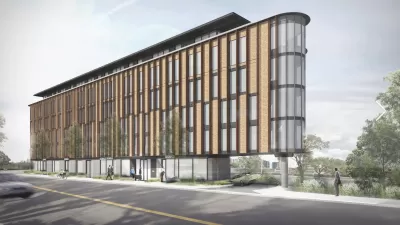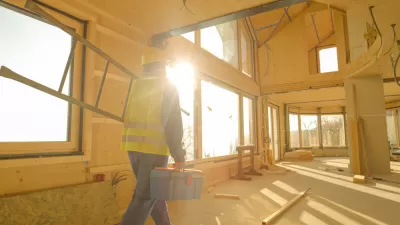Needing to expand to accommodate 35 million annual passengers by 2045 but constrained by Portland’s urban growth boundary, PDX had to think outside the box when planning its expansion. The result is a case study in sustainability.

The first phase of the nearly $2 billion expansion and renovation of Portland International Airport, commonly known as PDX, opened in August. It’s a novel project that has turned PDX into America’s largest mass-timber airport and, according to a recent article from Metropolis, represents a massive milestone for the mass-timber industry. It’s also an example of innovative, creative thinking to address a spate of challenges, including limited space for expansion because of the local urban growth boundary, lack of feasibility around building conjoining existing buildings, the need for seismic resilience against earthquakes, and the fact the existing terminal needed to stay operational during construction, and a desire for sustainability. The solution? Prefabricate a nine-acre wood roof at the edge of PDX’s grounds and slide it into place over top the existing, operational terminal.
“By choosing [a] rebuild over a new airport, the project reduced its carbon footprint by 70 percent, but this required complicated choreography,” Brian Libby, reports for Metropolis. The roof is made with 3.5 million board feet of Douglas Fir sourced from landowners and mills within a 300-mile radius of the airport. According to the article, “The just-completed first phase, built underneath [the timber roof], includes new check-in counters, a Market Hall lined with local businesses, enlarged security checkpoints, and a so-called ‘walk in the forest’: that includes 5,000 plants and 72 mature black walnut, ficus, and olive trees, courtesy of Portland landscape architecture studio PLACE. Phase 2, with passenger exit lanes, additional shopping-dining areas, and north-south views through walls of glass, opens in late 2025.”
FULL STORY: Forest to Frame: Why Portland’s Airport is a New Milestone for Mass Timber

Planetizen Federal Action Tracker
A weekly monitor of how Trump’s orders and actions are impacting planners and planning in America.

Canada vs. Kamala: Whose Liberal Housing Platform Comes Out on Top?
As Canada votes for a new Prime Minister, what can America learn from the leading liberal candidate of its neighbor to the north?

The Five Most-Changed American Cities
A ranking of population change, home values, and jobs highlights the nation’s most dynamic and most stagnant regions.

San Diego Adopts First Mobility Master Plan
The plan provides a comprehensive framework for making San Diego’s transportation network more multimodal, accessible, and sustainable.

Housing, Supportive Service Providers Brace for Federal Cuts
Organizations that provide housing assistance are tightening their purse strings and making plans for maintaining operations if federal funding dries up.

Op-Ed: Why an Effective Passenger Rail Network Needs Government Involvement
An outdated rail network that privileges freight won’t be fixed by privatizing Amtrak.
Urban Design for Planners 1: Software Tools
This six-course series explores essential urban design concepts using open source software and equips planners with the tools they need to participate fully in the urban design process.
Planning for Universal Design
Learn the tools for implementing Universal Design in planning regulations.
Village of Glen Ellyn
Central Transportation Planning Staff/Boston Region MPO
Heyer Gruel & Associates PA
Institute for Housing and Urban Development Studies (IHS)
City of Grandview
Harvard GSD Executive Education
Regional Transportation Commission of Southern Nevada
Toledo-Lucas County Plan Commissions





























